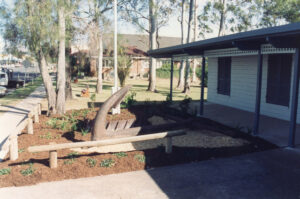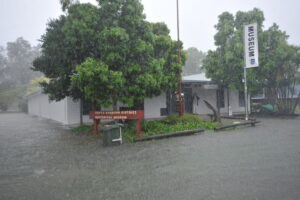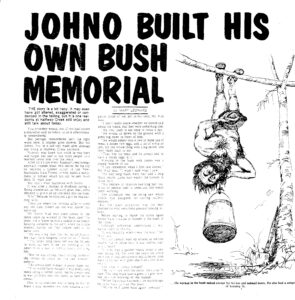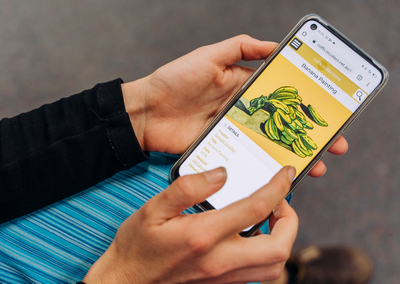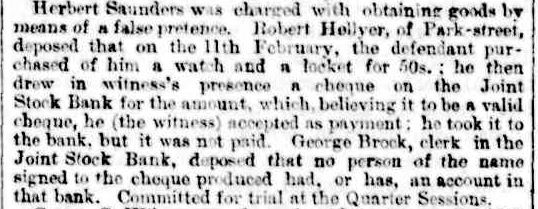This is a guest post authored by Mr Brian Crossingham.

Richard William John Crossingham and his wife Amelia May (Townsend) were stationed on South Solitary Island for 10 years from 1883 to 1893. Richard was just the 5th Keeper to be appointed to South Solitary Island. He was a builder and stone mason and he and Amelia had married in St Leonards in January 1883 and took his first appointment with the service as 2nd Assistant Keeper, South Solitary in July 1883. He subsequently went on to serve in all three Keeper roles – being promoted to the Principal Lightkeeper’s role in 1890 when the then Principal, Robert Kelly, was transferred to the newly constructed Lighthouse at Smoky Cape.
Robert Kelly ‘s health unfortunately failed a few years on, and he passed away in June of 1893. Richard was selected as his replacement and was appointed Principal Smoky Cape on 1st July 1893. Following almost 10 years at Smoky Cape, Richard was then selected for the Principal Keepers role at Barrenjoey Lighthouse (Broken Bay) where he served from March 1903 until his retirement from the service in April 1905.
On retirement Richard, Amelia and the family returned to the Macleay Valley and established a dairy farm at Long Reach on the Macleay River – near the village of Jerseyville ( Pelican Island) and not far from Smoky Cape Lighthouse.
Children of the Island
Richard and Amelia had 10 children in all – seven while at SSIL – five boys and two girls – with their first-born Richard James born on Christmas Day 1883 on board the SS Platypus enroute to Sydney. Two boys were born on the island itself. They had a further three children while at Smoky Cape – two girls and a boy – all were born at the Lightstation.
Their farm was prosperous at Long Reach. However, the world changed with the outbreak of World War I. Three of Richard and Amelia’s sons – William Arthur, Leonard Sydney and George Henry – born during the days their father was assigned to South Solitary Island, enlisted in the Australian Imperial Force in 1916.
William Arthur Crossingham was born on February 9, 1885, at his grandfather’s farm at Pipe Clay Creek near Moorland just north of Taree on the NSW coast.
Leonard Sydney Crossingham was born on May 23, 1889 in St. Leonards Sydney.
George Henry Crossingham was born August 10, 1891 at South Solitary Island Lighthouse.
Growing up at South Solitary Island and then Smoky Cape appears to have served them well – perhaps it was the diet based around fish and the coastal life? – whatever it was, in their medicals all three measured just on six feet.
Life would never be the same again
William and George were lost, and Leonard was wounded in action on three occasions. This had a profound effect on the family.
All three brothers enlisted at Kempsey on the 21st July 1916 and went into camp at Rutherford, near Maitland. They were taken into the 33rd Battalion – 5th Reinforcements on 22nd September 1916.
After final leave back home to the Macleay the three brothers transferred to Liverpool Camp to prepare for embarkation. Embarking on the SS Port Napier in a group of 152 from the 5th Reinforcements they joined other Reinforcement Ranks for other Battalions and sailed from Sydney on 17th November 1916.
The SS Port Napier steamed to Albany, Western Australia where the convoys were marshalled and then to Durban, South Africa. After a brief stopover they continued west around the Cape of Good Hope and headed northwards along the West African coast – arriving in Devonport on 29 January 1917 – into the dead cold of one of the bleakest winters experienced.
The 5th Reinforcements travelled to Larkhill in Wiltshire (by rail) and were marched into the 9th Australian Training Battalion at Durrington on the 30th January. It was there they trained in the practice of trench warfare.
THE CROSSINGHAM BROTHERS
No. 2540 Private William Arthur Crossingham, 33rd Battalion AIF
On arrival at Larkhill William was ill – seriously ill according to his records – and was admitted to the base hospital then transferred to King George Hospital in London on 8th February where he passed away two weeks later on 22nd February 1917. His record states he “Died of Disease (Pneumonia)”.

He was buried on the February 26 in the Commonwealth War Graves Cemetery at Brookwood outside London. The Military Funeral was attended by representatives of Headquarters in London and the coffin was carried by Australian troops – the records show George and Leonard were both in attendance along with their mother’s sister Margaret (Mrs. Vere.)
William had stepped up when it was required, signed up and was prepared to put his life on the line for his country travelling to the other side of the world not knowing what he may face – he carried out his duty. Disease turned out to be his enemy.

Leonard and George continued their training and on 5 April 1917, proceeded along with 70 other reinforcements to France and joined the 33rd Battalion billeted in Armentieres on April 28. Both were posted to “C” Company.
George volunteered to be a Stretcher Bearer (SB). He was subsequently transferred to Headquarters along with others in November 1917 into the Battalion company.
Leonard and George continued to do as much as possible together, particularly spending leave in England where they would meet with their maternal Grandparents and mother’s family.
No. 2542 (SB) Private George Henry Crossingham MM, 33rd Battalion AIF
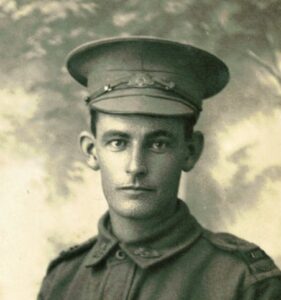
In a letter to his father and published in the Macleay Chronicle 10 July 1918 Leonard describes the battle leading to what would be George’s last action. An abridged version appears below.
“George and I were on leave to England but got back to France in time to join up with our Battalion on the evening of March 21 when the big battle started. So off we went and were put into battle straight away. As the Australian Divisions used to push the enemy back in one place they were shifted on down the battle front to wherever else a break-through was being attempted; we kept this going till we had covered a hundred miles or so.
After beating back the Germans at every point at which we fought them we had two days spell during which we organised for a bigger stunt on the third day. We had to regain a village and a wood which the enemy had just previously taken from the Tommie’s. After heavy fighting we drove the enemy back 900 yards. In that nights fight we had 170 men killed and wounded and left enemy dead all over. ……… next morning, we moved on to the Village of Villers- Bretonneux two miles away. We started the Villers – Bretonneaux battle on April 4 and then we had 3 big battles in 36 hours. ………
……. we never had such a trying time in our lives. On my left the rest of the boys were fighting with the bayonet for 6 hours ……. We were shooting for all we were worth; the enemy came so thickly that we mowed them down as they came walking along. My Lewis gun team fired nearly all their bullets away and they and we had to take to our rifles. Just then one of the boys yelled out “stretcher bearers”. Of course, George was one and he jumped up about 10 yards from me. As he was bandaging a wounded lad, he got wounded himself. Something made me look around and I saw poor George walking off the field. I looked around saw a faint little smile on his face. I thought to myself that he had a nice little wound that would give him about 3 months spell in England. So I went on fighting and when the stretcher bearers returned from the dressing station they brought me a little note from George in which he said: “Leon I am done this time, say good bye to all my mates for me”
Then I began to worry about him. After a couple of days had passed the second division of Australians relieved us, so we went back a short distance for a spell and ‘eat up. Our big guns were just getting busy and putting gas shells over when our platoon officer sent for me – “Leon I have sad news for you, your brother died at the Casualty Clearing Station. You can go out tonight”. I went but only for a day and a night. The next night we were all gassed and blind so off to hospital went 350 of my battalion. I am now in Birmingham (England) hospital where I find myself doing fairly well. Poor George was wounded through the back and the bullet stopped in his stomach, that is how it came to kill him. He was recommended for the M.M. or D.S.O. One thing dad is he died a hero, did things under heavy shell and machine gun fire that a lot of us would not have done. I am sending you a photo of the last battle in which George and I fought together – where the Australians took Villers – Bretonneaux and saved the British Army.”
George was posthumously awarded the Military Medal for his actions in what has been called the 1st Battle of Villers-Bretonneux.
The recommendation read in part
“For conspicuous Gallantry and devotion to duty. During operations of 4th April 1918, east of Villers Bretonneau, Private Crossingham acted as a stretcher bearer. Although under very heavy machine gun and rifle fire, he moved freely in the open attending the wounded. He worked without rest until he himself was wounded on the afternoon of April 5th while tending a wounded man. By his splendid courage and contempt of all danger he set all ranks a high example. He was undoubtedly the means of saving the lives of many men.”
George was buried in the Picquigny British Cemetery in France.

No. 2539 Private Leonard Sydney Crossingham 33rd Battalion AIF

We take up Leonard’s story back when he and George completed training in England……
Leonard and George continued their training and on April 5, 1917, proceeded along with 70 other reinforcements to France and were taken on strength with the 33rd Battalion billeted in Armentieres on April 28. Both were posted to “C” Company.
Leonard was wounded in action on three occasions over the course of his deployment in France. On 7th June 1917 during the Battle of Messines he was wounded by poisonous Gas. The enemy had shelled the area around Hill 63 and Ploegsteert Wood and over 500 Australian casualties from Gas were recorded. Len was Treated in France and returned to duty 7 weeks later 25th of July.
On 5th October 1917 in the lead up to the Battle of Passchendaele (9 – 12 October 1917) Len was again wounded, suffering a Gun Shot Wound (GSW) to the knee – He was treated in France and returned to duty 5 weeks later on 10th November.
Shortly after George’s death on 5th April 2018, Len was seriously wounded in action by Poison Gas on the 17th April –– On the night of the 16th and early morning of the 17th the Germans had saturated the trenches near Villers Bretonneux and Cachey in a 3 hour barrage in the predawn with phosgene, mustard, and irritant gasses. In anticipation of an attack the town Garrison and remnants of the 33rd were moved out quickly from their shelters in the town and into the trenches. The attack did not come! Instead, they were bombarded again in the evening for another 3 hours. Len was wounded – for the third time however this was much more serious than the first time he was gassed. There were many gas casualties in that operation. Len was admitted to hospital in Rouen in France, then transferred to England – firstly to the 1st Southern General Hospital in Edgbaston and then to the First Auxiliary Hospital at Harefield. He was improving and allowed leave and then admitted on return to No.3 Command Depot, Hurdcott before being transferred to No 1 Command Depot at Sutton Veny.
The exposure to gas at Villers Bretonneux was by far the most serious. For context there were more than 1,027 casualties in that Gas Attack including the Commanding Officer of the 33rd Battalion, Lieutenant Colonel Morshead. He was less serious but was still off the line for some 3 weeks as a result.
Tragedy was to strike the family back home on 3rd September when Leonard’s father Richard received news that his wife Amelia had taken ill while visiting her sister in Sydney. She had been ill over time but had improved lately and made the trip to Sydney. Almost immediately after the first news a second telegram said she had passed away.
“We deeply regret to report that trouble keeps crowding in on Mr. R.W.J. Crossingham of Long Reach, who our readers will remember lost two sons on active service in France, while a third is seriously ill in hospital in England; for yesterday he received a telegram announcing the serious illness of his wife, and an hour or so later a further wire reporting her death. In delicate health for some time, Mrs Crossingham had her illness much aggravated by grief for her sons, but a slight improvement a few weeks ago encouraged her to take a trip to Sydney; and the move has proved a fatal one. Mr Crossingham, accompanied by a daughter, left for Sydney Tuesday Evening.”
(Macleay Chronicle – Wed 4 Sep 1918 UNEXPECTED DEATH)
Leonard eventually returned to his unit in France on the 29th October 1918 after 6 long months in recovery. The 33rd Battalion had been relieved and stood down and was then billeted in Citerene.
On the night before Armistice day he wrote to his future bride, Janet Saul of Bellimbopinni, Macleay River and was full of hope for a speedy return to Australia. This would however be a lengthy process. It would be nearly 5 months before Len even saw England again – disembarking on 22nd April 1919.
It would be another seven weeks in England before he embarked the Hospital Transport “Themistocles” leaving England for Australia on 12th June 1919. Len disembarked in Sydney on 10th August 1919 – nine months on from his postcard.
The Macleay Argus of Thursday 21 August 1919, contained a detailed article of a welcome home put on by the “Pride of Clybucca Lodge, G.U.O.O.F “(Grand United Order of Oddfellows) the night before, for Len and another soldier “Trooper Price”. A big event with a large turnout with local Councillors and dignitaries – the reporter writes of Len –
“On the platform …. Mr. W. Crossingham and Misses Crossingham (3) and Mrs. Parish, Father and Sisters of Bro. Pte. Crossingham…..”
“Sister Crossingham pinned a medal to her brothers tunic” ……..”Pte. Crossingham felt very proud to be amongst them. There was no one wished to be back more than he did. He had been looking forward for a long time to getting back to his people and dear old Aussie and he thanked them for the kind way they had shown their wishes to him. He thanked the women workers and all the people that sent parcels across to him in France whilst he was away. There were none of them knew how much the boys appreciated those things in France. (Applause)”
Leonard Sydney Crossingham recovered from his wounds, married Janet Saul, raised a family in Smithtown on the Macleay River and lived to the age of 76.
References and Acknowledgements
Story: Brian Roy Crossingham
For information and context within the article: Crossingham Family Collection – Photos and Collective Knowledge
The Harrower Collection 9th Infantry Brigade AIF – David John Harrower ACM. 2015
33rd Battalion 1st AIF – Home | Facebook – Rod Carpenter
Never a Backward Step- A History of the 33rd Battalion: John Edwards 1996
National Archives of Australia – Military Service Records:
NAA: B2455, CROSSINGHAM W A
NAA: B2455, CROSSINGHAM L S
NAA: B2455, CROSSINGHAM G A
Fallen Brothers of the Macleay 1914-1918; Jocelyn Bakewell and Debbie Reynolds; Kempsey Family History Group Publication, 2021
Macleay Fallen – Volunteers from the Macleay River Valley who paid the Supreme Sacrifice in the War of 1914-1918; Philip Lee; published by the Macleay River Historical Society 2021
SOLDIER’S LETTER. (1918, July 10). The Macleay Chronicle (Kempsey, NSW : 1899 – 1952), p. 3. http://nla.gov.au/nla.news-article174429391
UNEXPECTED DEATH. (1918, September 4). The Macleay Chronicle (Kempsey, NSW : 1899 – 1952), p. 4.
ODDFELLOWS WELCOME. (1919, August 21). Macleay Argus (Kempsey, NSW : 1885 – 1907; 1909 – 1910; 1912 – 1913; 1915 – 1916; 1918 – 1954), p. 5.





